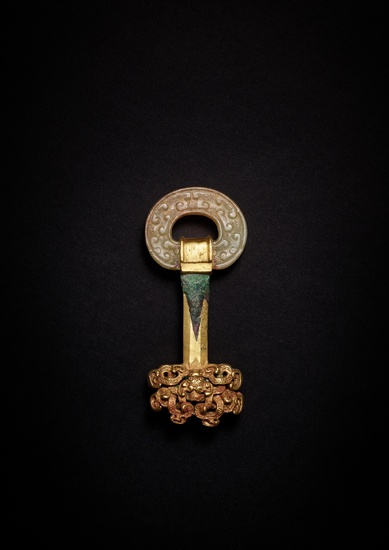An exceptional and rare gold, jade and bronze pendant, Eastern...
Property from an Important Japanese Collection
An exceptional and rare gold, jade and bronze pendant,
Eastern Zhou dynasty, late 5th - 4th century BC
日本顯赫收藏
東周公元前五世紀末至四世紀 金鏤空蟠螭紋鑲勾雲紋玉環青銅垂飾
7.7 cm
Condition Report:
A possible restoration to lower part of the bronze shaft above the hook, with malachite encrustation, otherwise in overall good condition with gold and jade ring well preserved. X-ray available on request.
銅軸近鑲玉鉤處或經修補並見綠鏽,其餘品相良好。X光片備索。
Catalogue Note:
Combining a delicately carved jade ring, intricate gold openwork and an inlaid bronze shaft, this piece displays the heights of early Chinese craftsmanship across diverse media. With the advent of lost-wax casting techniques, the Eastern Zhou dynasty saw the rise of incredibly complex cast gold forms. Featuring a tangled profusion of dragons, meeting in the middle with two eyes and a snout, the gold fitting makes a clear nod to archaic zoomorphic motifs while building on them with new technical prowess.
Developing in tandem, Eastern Zhou jade carvers adopted and adapted fashionable metalworking motifs and incorporated them into their designs. Bringing balance to this piece and mirroring the writhing dragons of the gold fitting, the jade ring, elliptical in shape, is embellished with stylised dragons in the form of ‘C’ scrolls with circles for eyes on a hatched background.
Pieces of this kind combining gold, jade and bronze are exceedingly rare. A set of similar jade rings with gold fittings (recorded as knife pommels), found at Jinshengcun, is illustrated in La Civiltà del Fiume Giallo, Rome, 1992, cat. no. 58. Closely related gold openwork can be found on the hilt of a bronze knife excavated from Shangguodiancun, now in the Fengxiang County Museum (accession no. zong-1004), illustrated in Everlasting Like the Heavens: The Cultures and Arts of the Zhou, Qin, Han, and Tang, Shanghai, 2019, p. 221. See also another widely exhibited dagger hilt in the British Museum (accession no. 1937,0416.218) which Jessica Rawson compares with contemporaneous jades in Chinese Jade: From the Neolithic to the Qing, London, 1995, fig. 46.
A closely related pommel, in which a serpentine jade scroll takes the place of the gold fitting here, was excavated from the tomb of Marquis Yi of Zeng, among many similar jade discs and openwork gilt bronze dragons, illustrated in The Unearthed Cultural Relics From Lei Gu Dun, Sui Zhou, Hu Bei Province, Hong Kong, 1984, cat. no. 65.
青銅作軸,綴金鑲玉,見證中國早期工藝的出神入化。東周時期,隨著失蠟鑄造技術的出現,鑄金飾件窮思極巧。此件金鑄鏤空蟠螭交纏,匯於中心,聚焦兩目一吻,龍首乍現,在承襲高古獸紋的基礎上,精益求精。配以雲紋玉環,平衡金鏤蟠螭,相得映彰。
嵌玉綴金的銅飾極罕,金勝村出土一組飾金玉環,指乃刀首,見《La Civiltà del Fiume Giallo》,羅馬,1992年,編號58。鳳翔縣博物館也有出土例,藏品編號:中1004。另可比較倫敦大英博物館名品匕首金飾,藏品編號:1937,0416.218。
Provenance:
Eskenazi Ltd, London, 1993.
埃斯卡納齊,倫敦,1993年
View it on
Sale price
Estimate
Time, Location
Auction House
Property from an Important Japanese Collection
An exceptional and rare gold, jade and bronze pendant,
Eastern Zhou dynasty, late 5th - 4th century BC
日本顯赫收藏
東周公元前五世紀末至四世紀 金鏤空蟠螭紋鑲勾雲紋玉環青銅垂飾
7.7 cm
Condition Report:
A possible restoration to lower part of the bronze shaft above the hook, with malachite encrustation, otherwise in overall good condition with gold and jade ring well preserved. X-ray available on request.
銅軸近鑲玉鉤處或經修補並見綠鏽,其餘品相良好。X光片備索。
Catalogue Note:
Combining a delicately carved jade ring, intricate gold openwork and an inlaid bronze shaft, this piece displays the heights of early Chinese craftsmanship across diverse media. With the advent of lost-wax casting techniques, the Eastern Zhou dynasty saw the rise of incredibly complex cast gold forms. Featuring a tangled profusion of dragons, meeting in the middle with two eyes and a snout, the gold fitting makes a clear nod to archaic zoomorphic motifs while building on them with new technical prowess.
Developing in tandem, Eastern Zhou jade carvers adopted and adapted fashionable metalworking motifs and incorporated them into their designs. Bringing balance to this piece and mirroring the writhing dragons of the gold fitting, the jade ring, elliptical in shape, is embellished with stylised dragons in the form of ‘C’ scrolls with circles for eyes on a hatched background.
Pieces of this kind combining gold, jade and bronze are exceedingly rare. A set of similar jade rings with gold fittings (recorded as knife pommels), found at Jinshengcun, is illustrated in La Civiltà del Fiume Giallo, Rome, 1992, cat. no. 58. Closely related gold openwork can be found on the hilt of a bronze knife excavated from Shangguodiancun, now in the Fengxiang County Museum (accession no. zong-1004), illustrated in Everlasting Like the Heavens: The Cultures and Arts of the Zhou, Qin, Han, and Tang, Shanghai, 2019, p. 221. See also another widely exhibited dagger hilt in the British Museum (accession no. 1937,0416.218) which Jessica Rawson compares with contemporaneous jades in Chinese Jade: From the Neolithic to the Qing, London, 1995, fig. 46.
A closely related pommel, in which a serpentine jade scroll takes the place of the gold fitting here, was excavated from the tomb of Marquis Yi of Zeng, among many similar jade discs and openwork gilt bronze dragons, illustrated in The Unearthed Cultural Relics From Lei Gu Dun, Sui Zhou, Hu Bei Province, Hong Kong, 1984, cat. no. 65.
青銅作軸,綴金鑲玉,見證中國早期工藝的出神入化。東周時期,隨著失蠟鑄造技術的出現,鑄金飾件窮思極巧。此件金鑄鏤空蟠螭交纏,匯於中心,聚焦兩目一吻,龍首乍現,在承襲高古獸紋的基礎上,精益求精。配以雲紋玉環,平衡金鏤蟠螭,相得映彰。
嵌玉綴金的銅飾極罕,金勝村出土一組飾金玉環,指乃刀首,見《La Civiltà del Fiume Giallo》,羅馬,1992年,編號58。鳳翔縣博物館也有出土例,藏品編號:中1004。另可比較倫敦大英博物館名品匕首金飾,藏品編號:1937,0416.218。
Provenance:
Eskenazi Ltd, London, 1993.
埃斯卡納齊,倫敦,1993年



